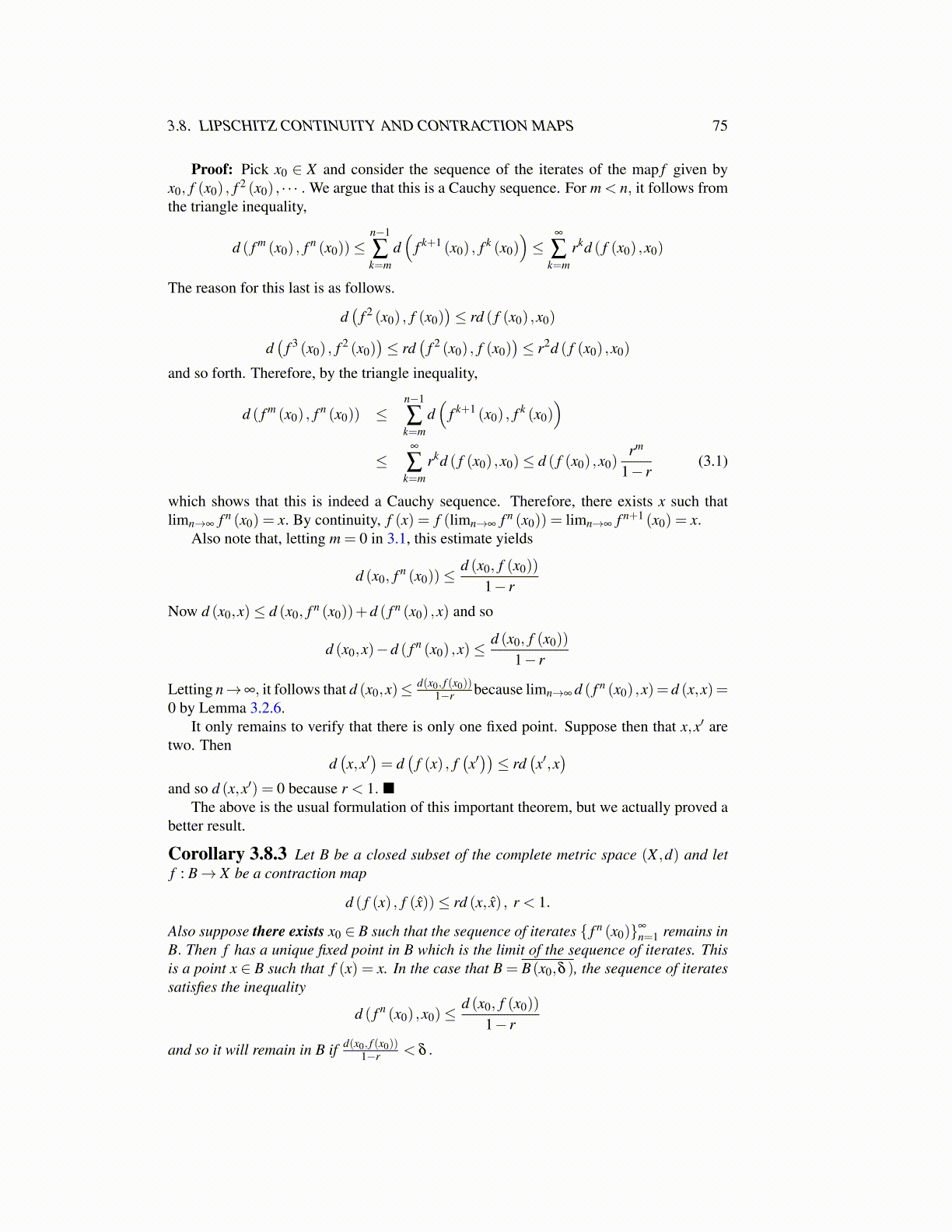
3.8. LIPSCHITZ CONTINUITY AND CONTRACTION MAPS 75
Proof: Pick x0 ∈ X and consider the sequence of the iterates of the map f given byx0, f (x0) , f 2 (x0) , · · · . We argue that this is a Cauchy sequence. For m < n, it follows fromthe triangle inequality,
d ( f m (x0) , f n (x0))≤n−1
∑k=m
d(
f k+1 (x0) , f k (x0))≤
∞
∑k=m
rkd ( f (x0) ,x0)
The reason for this last is as follows.
d(
f 2 (x0) , f (x0))≤ rd ( f (x0) ,x0)
d(
f 3 (x0) , f 2 (x0))≤ rd
(f 2 (x0) , f (x0)
)≤ r2d ( f (x0) ,x0)
and so forth. Therefore, by the triangle inequality,
d ( f m (x0) , f n (x0)) ≤n−1
∑k=m
d(
f k+1 (x0) , f k (x0))
≤∞
∑k=m
rkd ( f (x0) ,x0)≤ d ( f (x0) ,x0)rm
1− r(3.1)
which shows that this is indeed a Cauchy sequence. Therefore, there exists x such thatlimn→∞ f n (x0) = x. By continuity, f (x) = f (limn→∞ f n (x0)) = limn→∞ f n+1 (x0) = x.
Also note that, letting m = 0 in 3.1, this estimate yields
d (x0, f n (x0))≤d (x0, f (x0))
1− r
Now d (x0,x)≤ d (x0, f n (x0))+d ( f n (x0) ,x) and so
d (x0,x)−d ( f n (x0) ,x)≤d (x0, f (x0))
1− r
Letting n→∞, it follows that d (x0,x)≤ d(x0, f (x0))1−r because limn→∞ d ( f n (x0) ,x)= d (x,x)=
0 by Lemma 3.2.6.It only remains to verify that there is only one fixed point. Suppose then that x,x′ are
two. Thend(x,x′)= d
(f (x) , f
(x′))≤ rd
(x′,x)
and so d (x,x′) = 0 because r < 1. ■The above is the usual formulation of this important theorem, but we actually proved a
better result.
Corollary 3.8.3 Let B be a closed subset of the complete metric space (X ,d) and letf : B→ X be a contraction map
d ( f (x) , f (x̂))≤ rd (x, x̂) , r < 1.
Also suppose there exists x0 ∈ B such that the sequence of iterates { f n (x0)}∞
n=1 remains inB. Then f has a unique fixed point in B which is the limit of the sequence of iterates. Thisis a point x ∈ B such that f (x) = x. In the case that B = B(x0,δ ), the sequence of iteratessatisfies the inequality
d ( f n (x0) ,x0)≤d (x0, f (x0))
1− r
and so it will remain in B if d(x0, f (x0))1−r < δ .